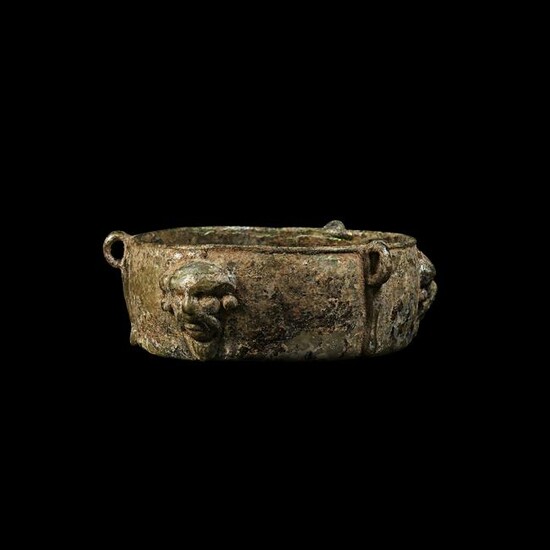Roman Glass Lamp with Satyr Masks
3rd-4th century AD. A cylindrical translucent glass lamp with rounded lip and almost vertical sides, decorated with three grotesque Bacchic satyr masks in high-relief, each having long narrow faces, large eyes and mouth, the hair with entwined grapes; three applied moulded ring supports for the suspension chain, each with a claw projecting from beneath; traces of gilding to the surfaces; possibly some restoration. See Daremberg & Saglio, Dictionnaire des Antiquités Grecques et Romaines, Paris, 1873-1917; Whitehouse, D., Roman Glass in the Corning Museum of Art, New York, 2001, volume I, pp.193ff. no.338, vol. II, pp.227-228, no.799; Harden, D.B., Glass of the Caesars, Milan, 1987, no.113. 255 grams, 14cm (5 1/2"). Property of a Kensington lady; acquired in France in 1988; accompanied by a hardbacked positive scientific report no.0217-OA-36R-1 from CIRAM SAS, Bordeaux, France, and an archaeological report by Dr. Raffaele D’Amato; this lot has been checked against the Interpol Database of stolen works of art and is accompanied by AIAD certificate number no.10582-173407. Advanced glass blowing techniques brought new technology to Rome in the form of window glass, hanging glass lamps, mirrors and other objects. The three loop handles on the object here suggest that it was intended to be suspended, hence it can be identified as a lamp. The discovery of the combustible properties of olive oil was crucial for the history of ancient lighting. If the moulded lamps of the 1st-2nd century were affordable, the oil remained relatively expensive since it was imported from Spain and Africa. The cost and supply difficulties probably explain why Romans turned to tallow lamps or candlesticks in the 3rd century. It was at this time that the lamps decorated with globules and the terracotta candlesticks appeared.
Condition Report: Fine condition.
View it on
Estimate
Time, Location
Auction House
3rd-4th century AD. A cylindrical translucent glass lamp with rounded lip and almost vertical sides, decorated with three grotesque Bacchic satyr masks in high-relief, each having long narrow faces, large eyes and mouth, the hair with entwined grapes; three applied moulded ring supports for the suspension chain, each with a claw projecting from beneath; traces of gilding to the surfaces; possibly some restoration. See Daremberg & Saglio, Dictionnaire des Antiquités Grecques et Romaines, Paris, 1873-1917; Whitehouse, D., Roman Glass in the Corning Museum of Art, New York, 2001, volume I, pp.193ff. no.338, vol. II, pp.227-228, no.799; Harden, D.B., Glass of the Caesars, Milan, 1987, no.113. 255 grams, 14cm (5 1/2"). Property of a Kensington lady; acquired in France in 1988; accompanied by a hardbacked positive scientific report no.0217-OA-36R-1 from CIRAM SAS, Bordeaux, France, and an archaeological report by Dr. Raffaele D’Amato; this lot has been checked against the Interpol Database of stolen works of art and is accompanied by AIAD certificate number no.10582-173407. Advanced glass blowing techniques brought new technology to Rome in the form of window glass, hanging glass lamps, mirrors and other objects. The three loop handles on the object here suggest that it was intended to be suspended, hence it can be identified as a lamp. The discovery of the combustible properties of olive oil was crucial for the history of ancient lighting. If the moulded lamps of the 1st-2nd century were affordable, the oil remained relatively expensive since it was imported from Spain and Africa. The cost and supply difficulties probably explain why Romans turned to tallow lamps or candlesticks in the 3rd century. It was at this time that the lamps decorated with globules and the terracotta candlesticks appeared.
Condition Report: Fine condition.



